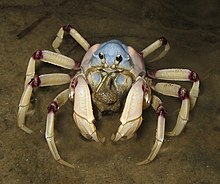
Tuerkayana hirtipes is a species of terrestrial crab.

Maja brachydactyla is a species of crab in the family Majidae. It was initially described as a subspecies of M. squinado. A review of the species complex published in 1998 was able to differentiate between specimens from the Mediterranean Sea and those from the Atlantic Ocean, and concluded that the Atlantic specimens were a separate species, accepted as M. brachydactyla Balss, 1922.

The stalk-eyed mud crab, Macrophthalmus hirtipes, is a marine large-eyed crab of the family Macrophthalmidae, endemic to New Zealand including Campbell Island. It grows to around 30 millimetres (1.2 in) shell width. It is either the only species in the subgenus Hemiplax and the most basal species in the genus Macrophthalmus, or the only species in the sister genus Hemiplax.

Discoplax is a genus of terrestrial crabs. It is very closely related to the genus Cardisoma.
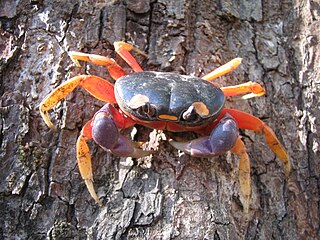
Gecarcinus is the type genus of the land crab family Gecarcinidae. They are found in warmer coastal regions of the Americas, including islands in the Caribbean. Four species from oceanic islands were formerly included in Gecarcinus as the subgenus Johngarthia, but are now treated as a separate genus, Johngarthia. While all members of this genus are largely terrestrial, they have to return to the ocean to breed. They are often colourful, with reddish, orange, purple, yellowish, whitish, or blackish being the dominating hues. This has resulted in some species, notably G. quadratus and G. lateralis, gaining a level of popularity in the pet trade.
Epigrapsus is genus of terrestrial crabs. The two species are omnivores.
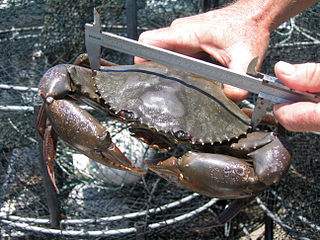
Scylla is a genus of swimming crabs, comprising four species, of which S. serrata is the most widespread. They are found across the Indo-West Pacific. The four species are:
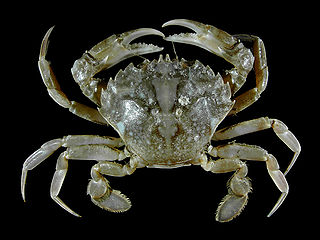
Eubrachyura is a group of decapod crustaceans comprising the more derived crabs. It is divided into two subsections, based on the position of the genital openings in the two sexes. In the Heterotremata, the openings are on the legs in the males, but on the sternum in females, while in the Thoracotremata, the openings are on the sternum in both sexes. This contrasts with the situation in other decapods, in which the genital openings are always on the legs. Heterotremata is the larger of the two groups, containing the species-rich superfamilies Xanthoidea and Pilumnoidea and all the freshwater crabs. The eubrachyura is well known for actively and constantly building its own burrows. The fossil record of the Eubrachyura extends back to the Cretaceous; the supposed Bathonian representative of the group, Hebertides jurassica, ultimately turned out to be Cenozoic in age.

Austruca perplexa is a species of fiddler crab. It is found from the Ryukyu Islands, Japan to India, throughout the Malay Archipelago, along eastern Australian coasts from Queensland to New South Wales, and in various Pacific islands, including Fiji, Tonga and Vanuatu.

Matutidae is a family of crabs, sometimes called moon crabs, adapted for swimming or digging. They differ from the swimming crabs of the family Portunidae in that all five pairs of legs are flattened, rather than just the last pair, as in Portunidae. Crabs in the Matutidae are aggressive predators.

Karstarma is a genus of karst-dwelling crabs formerly included in Sesarmoides.
Cyrtocarcinus truncatus is a species of crab in the family Xanthidae that lives in the waters around Hawaii. It was described in 1906 by Mary J. Rathbun as Harrovia truncata, based on a single immature male specimen caught near Kauai. Masatsune Takeda transferred the species to his new genus Glyptocarcinus in 1979, and Peter Ng and Diana Chia erected a new genus, Cyrtocarcinus, for this species alone, in 1994.

Glyptoxanthus is a genus of crabs in the family Xanthidae, containing eight species. It was originally erected by Alphonse Milne-Edwards in 1879 for six species previously placed in the genus Actaea and elsewhere. Although previously included in subfamily Euxanthinae, the genus has a quite distinct morphology from other genera in that group, and was placed in 2011 in the new, monotypic subfamily, Glyptoxanthinae by Jose Christopher Mendoza and Danièle Guinot.

Demania is a genus of crabs in the family Xanthidae, containing the following species:
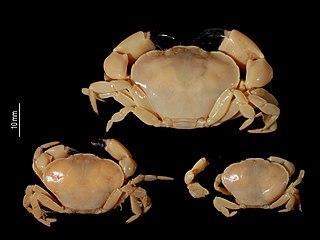
Euryxanthops is a genus of crabs in the family Xanthidae. It was originally established in 1983 by Garth & Kim to contain three species of deep-water crabs from Japan and the Philippines - Euryxanthops dorsiconvexus, Euryxanthops flexidentatus and Euryxanthops orientalis. Since then, several more species of this genus have been identified and described, and Euryxanthops currently contains:
Jacforus cavatus is a species of crab in the monotypic genus Jacforus in the family Xanthidae.
Linnaeoxanthus is a genus of crab, whose only species is Linnaeoxanthus acanthomerus. Linnaeoxanthus is the only genus of the family Linnaeoxanthidae.
Marratha angusta is a species of crabs in the family Xanthidae, the only species in the genus Marratha. It was originally described as Cycloxanthops angustus by Mary J. Rathbun in 1906, but was moved to a new genus in 2003; the name of the genus, Marratha, is an "arbitrary abbreviation" of Rathbun's name. It has been recorded from the Amirante Islands (Seychelles), Hawaii and the South China Sea.
Mictyris guinotae is a species of soldier crab of genus Mictyris, endemic to the Ryukyu Islands of Japan. They were named after Danièle Guinot, a professor at the Muséum national d'histoire naturelle in France, and were first treated as a separate species in a tribute volume to Guinot.
Danièle Guinot is a French biologist, an emeritus professor at the Muséum national d'histoire naturelle in France, known for her research on crabs.
